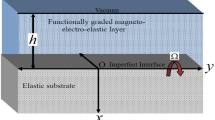Abstract
We have developed a three-dimensional (3-D) algorithm for computing the controlled-source audio-frequency magnetotelluric response which is capable of handling local inhomogeneities in the electrical conductivity and magnetic permeability distribution. It is a difference equation algorithm that is based on the integral forms of Maxwell’s equations. To avoid a spatial singularity being introduced by the source, we used a secondary electric field approach. We adopt a staggered-grid finite difference method to disperse the secondary electric field equation which is simple to realize and can calculate relatively complex models. The final sparse equation system after dispersion is solved using an ILU preconditioning quasi-minimal residual (QMR) method. The code is validated for nonmagnetic and permeable conductive structures by two synthetic models. One of them is a two-dimensional (2-D) nonmagnetic conductive geoelectric model; we validate our 3-D computation result by comparing it to the result of 2-D CSEM finite element forward program. The other one is a 3-D permeable geoelectric model; we validate our 3-D computation result by using the COMSOL Multiphysics software. We also designed two theoretical 3-D geoelectrical models to analyze the effects of magnetic permeability heterogeneity. Numerical simulation results well reveal the influence of magnetic permeability heterogeneity on high-resistance and low-resistance models.
















Similar content being viewed by others
References
Antonio T, Giulia DGM, Zaccaria P, Domenico P (2009) Imaging 2-D structures by the CSAMT method: application to the Pantano di S. Gregorio Magno faulted basin (southern Italy). J Geophys Eng 6:120–130
Beard L, Nyquist J (1998) Simultaneous inversion of airborne electromagnetic data for resistivity and magnetic permeability. Geophysics 63:1556–1564
Farquharson C, Oldenburg D, Routh P (2003) Simultaneous 1D inversion of loop–loop electromagnetic data for magnetic susceptibility and electrical conductivity. Geophysics 68:1857–1869
Fraser DC (1973) Magnetite ore tonnage estimates from an aerial electromagnetic survey. Geo-exploration 11:97–105
Fraser D (1981) Magnetite mapping with a multicoil airborne electromagnetic system. Geophysics 46:1579–1593
Fu C, Di Q, An Z (2013) Application of the CSAMT method to groundwater exploration in a metropolitan environment. Geophysics 78:B201–B209
Heagy LJ, Oldenburg DW (2013) Investigating the potential of using conductive or permeable proppant particles for hydraulic fracture characterization, SEG Technical Program Expanded Abstracts, 576–580
Hu X, Peng R, Wu G, Wang W, Huo G, Han B (2013) Mineral exploration using CSAMT data: application to Longmen region metallogenic belt, Guangdong Province, China. Geophysics 78:B111–B119
Huang H, Won IJ (2000) Conductivity and susceptibility mapping using broadband electromagnetic sensors. J Environ Eng Geophys 5:31–41
Kerry K (2012) MARE2DEM: a 2-D inversion code for controlled-source electromagnetic and magnetotelluric data. Geophys J Int 207:571–588
Kyubo N, Seokmin O, Jee SS, Ha LK, Joongmoo B (2016) Analysis of anomalous electrical conductivity and magnetic permeability effects using a frequency domain controlled-source electromagnetic method. Geophys J Int 204:1550–1564
Mukherjee S, Everett ME, Benavides AI, Fernandes R (2012) Mutual coupling of conductive, permeable targets and its effects on CSEM response, SEG Technical Program Expanded Abstracts, 1–6
Pavlov DA, Zhdanov MS (2001) Analysis and interpretation of anomalous conductivity and magnetic permeability effects in time domain electromagnetic data. Part I: numerical modeling. J Appl Geophys 46:217–233
Sasaki Y, Kim J, Cho S (2010) Multidimensional inversion of loop-loop frequency-domain EM data for resistivity and magnetic susceptibility. Geophysics 75:F213–F223
Smith JT (1966) Conservative modeling of 3-D electromagnetic fields, part II: biconjugate gradient solution and an accelerator. Geophysics 61(5):1319–1324
Ward SH (1959) Unique determination of conductivity, susceptibility, size, and depth in multi-frequency electromagnetic exploration. Geophysics 24:531–546
Xi J, Cui D, Zhang W, Chen X (2016) Study of frequency airborne electromagnetic forward calculation and imaging under magnetic condition. Progr Geophys (in Chinese) 31(6):2700–2706
Yee KS (1966) Numerical solution of initial boundary value problems involving Maxwell’s equations in isotropic media. IEEE Trans Antennas Propag 14(3):302–307
Yi M, Sasaki Y (2015) 2-D and 3-D joint inversion of loop–loop electromagnetic and electrical data for resistivity and magnetic susceptibility. Geophys J Int 203:1085–1095
Younis A, El-Qady G, Abd Alla M, Abdel Zaher M, Khalil A, Al Ibiary M, Saraev A (2015) AMT and CSAMT methods for hydrocarbon exploration at Nile Delta, Egypt. Arab J Geosci 8:1965–1975
Zhang Z, Oldenburg D (1997) Recovering magnetic susceptibility data from electromagnetic data over a one- dimensional earth. Geophys J Int 130:422–434
Zhang Z, Oldenburg DW (1999) Simultaneous reconstruction of 1-D susceptibility and conductivity from electromagnetic data. Geophysics 64:33–47
Zuo X, Dong M, Gao F, Tian S (2020) The modeling of the electric heating and cooling system of the integrated energy system in the coastal area. J Coast Res 103(sp1):1022
Funding
This work was supported by the China Geological Survey project “Resources and Environment Bearing Capacity of Xiongan New Area and Construction of Transparent Xiongan Digital Platform” (China Aero Geophysical Survey & Remote Sensing Center for Natural & Resources) (No. DD20189143).
Author information
Authors and Affiliations
Corresponding author
Ethics declarations
Conflict of interest
The author(s) declare that they have no competing interests.
Additional information
Responsible Editor: Abdullah M. Al-Amri
This article is part of the Topical Collection on Geological Modeling and Geospatial Data Analysis
Rights and permissions
About this article
Cite this article
Song, H., Liang, S. Research on the forward modeling of controlled-source audio-frequency magnetotelluric in three-dimensional electrical conductivity and magnetic permeability heterogeneity media. Arab J Geosci 14, 793 (2021). https://doi.org/10.1007/s12517-021-07001-w
Received:
Accepted:
Published:
DOI: https://doi.org/10.1007/s12517-021-07001-w




